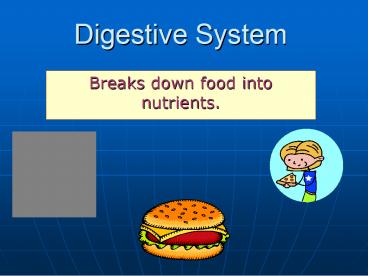Digestive System - PowerPoint PPT Presentation
1 / 14
Title:
Digestive System
Description:
Digestive System. Breaks down food into nutrients. Made up of: Mouth. Esophagus. Stomach ... Digestive Tract. Food travels through the following organs: 1. ... – PowerPoint PPT presentation
Number of Views:124
Avg rating:3.0/5.0
Title: Digestive System
1
Digestive System
- Breaks down food into nutrients.
2
Made up of
- Mouth
- Esophagus
- Stomach
- Small intestine
- Large intestine
- Rectum
- Anus
Food does not travel through
- Salivary glands
- Liver
- Pancreas
- Gall bladder
3
Types of Digestion
- Mechanical Digestion
- Grinding and mashing of food into smaller
pieces. - Chemical Digestion
- Breaking down of food into nutrients using acids
and enzymes
4
Proteins- Broken down into amino acids
Used to build muscle Carbohydrates- Broken do
wn into simple sugars Used for energy Fats-
Broken down into fatty acids Used for stored e
nergy
5
Digestive Tract
- Food travels through the following organs
1.Mouth 2.Esophagus 3.Stomach 4.Small intestine
5.Large Intestine 6.Rectum 7.Anus
6
1. Mouth
- Digestion begins here. Both mechanical and
chemical digestion take place. - Teeth will chew and mash food into smaller
pieces. (mechanical digestion) - Salivary glands found around your mouth produce
saliva that begin chemical digestion of
carbohydrates.
7
2. Esophagus
- The esophagus is a long tube that connects the
mouth to the stomach. - Food moves through the esophagus by peristalsis.
- Peristalsis is a rhythmic muscle contraction that
squeeze food down.
8
3. Stomach
Bag-like organ where digestion occurs.
- Mechanical digestion takes place when the stomach
churns. - Chemical digestion takes place when acids
breakdown food into nutrients. - After 2-4 hours your food becomes a soupy mixture
called chyme.
9
4. Small Intestine
Long but narrow tube where final digestion takes
place.
- Chemical digestion takes place in the small
intestine. Enzymes digest proteins and fats. - Nutrients are absorbed into the bloodstream
through villi. - Villi are finger-like projections found in the
small intestine.
Villi
10
Bile
- Bile helps to digest fats in the small
intestine. - Bile is made in the liver and stored in the gall
bladder.
11
Pancreas
- The pancreas releases chemicals (pancreatic
juices) into the small intestine to help
digestion. - Stomach acid is neutralized with bicarbonate
before it enters the small intestine.
12
5. Large Intestine
- Undigested food ends up in the large intestine.
- Excess water is removed from undigested food to
create solid waste. - 6. Rectum -Solid waste or feces is stored here.
- 7. Anus -Solid waste leaves the body through here.
13
mouth
teeth
salivary glands
esophagus
stomach
liver
pancreas
gall bladder
large intestine
small intestine
anus
14
(No Transcript)































